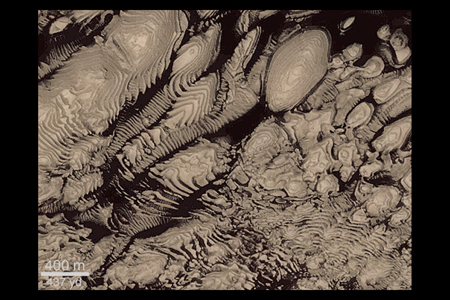
Mars Global Surveyor
Mars Orbiter Camera
Layers in Crater at 8°N, 7°W
MGS MOC Release No. MOC2-265B, 4 December 2000

Erosion has exposed hundreds of layers of the same thickness
and pattern on the floors of craters throughout western Arabia
Terra. This example comes from a crater at 8°N, 7°W.
In this view, dark windblown sand helps make the layers "stand
out" in sharp detail. Layers of repeated thickness and physical
expression such as these indicate repeated (cyclic or
episodic) patterns of change in the deposition of the sediments
that formed these rocks billions of years ago. The fact that they
tend to occur within martian impact craters might be an indicator
that these layers formed as sediments in a lake. Alternatively, they formed
from dust falling out of the air in an early martian environment
that was dynamic and capable of transporting more dust than
today's thin atmosphere (which is about 100 times thinner than
Earth's at the surface). This Mars Global Surveyor (MGS)
Mars Orbiter Camera (MOC) picture was taken in April 2000 and
is illuminated from the left/lower left. For additional information
about this picture, see
"Layered Material in West Arabia Terra Crater," MOC2-261, December 4, 2000.
Image Credit: NASA/JPL/Malin Space Science Systems
Malin Space Science Systems and the California Institute of
Technology built the MOC using spare hardware from the Mars Observer
mission. MSSS operates the camera from its facilities in San Diego,
CA. The Jet Propulsion Laboratory's Mars Surveyor Operations Project
operates the Mars Global Surveyor spacecraft with its industrial
partner, Lockheed Martin Astronautics, from facilities in Pasadena, CA
and Denver, CO.
 To MSSS Home Page
To MSSS Home Page


